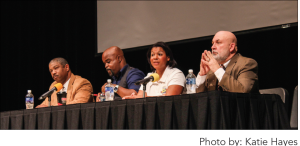Law enforcement and faculty discuss racial bias in policing
By: Sean E. Thomas
News Editor
On Wednesday, Feb. 22, Meramec hosted a panel to discuss current police-community relations. The Black Student Engagement and Empowerment Club organized the discussion and it was moderated by Dr. Emily Neal, associate professor of political science. The panel was comprised of Chief Anthony Russo of Meramec campus police, April Cayce, a retired officer currently with Serving with the Badge, Mario Love, an adjunct instructor of history and Anthony Anderson, a retired officer currently with the Police Athletic League.
The conversation began with a topic that has been at the forefront of police and community interactions: profiling.
“What can I do if I stop somebody and understand there’s that ‘I’m afraid’ mentality, what can I do to reduce your fear plus stay safe?” Russo asked.
This was the beginning of what became a recurring topic during the one-and-a-half-hour discussion, police safety during interactions with the community.This prompted a reference to the shooting death of Philando Castile on July 6, 2016 by an officer with the St. Anthony Police Department in Minnesota.
“That brief interaction resulted in the young man’s life,” Love said. “The officer would argue that there is a real…fear. Mr. Castile would probably argue that he had second amendment rights …but somewhere throughout that interaction, Mr. Castile lost his life.”
A question posed to Anderson by Meramec Student Liam Murphy regarding Anderson being both African-American and a police officer, was met with an explanation of why officers approach vehicles with their hands placed on their weapons, leaving the original question unanswered.
“The issue is ingrained with the system that we have now so we’re trying to make these small changes but they seem to all lead to a dead end,” Meramec student Craig Latiker said.
Russo continuously moved the topic of discussion back towards ways in which the community could help make police officers feel more safe during interactions.
“Here’s where I don’t think we do a very good job, we don’t train the public well enough,” said Russo.
Although acting as moderator, Neal could not help but interject with concerns of her own.
“Is it the community that needs to be trained, or is it the folks that chose that position in public service?” Neal asked.
Love offered his thoughts on problems facing citizens and law enforcement when interpreting and implementing the spirit of the Constitution. While recognizing that profiling can lead to the safety and successes for law enforcement, Love also pointed to some of the implications of this behavior.
“While racial profiling to law enforcement may be necessary, the consequences come in larger interpretations as to whether or not individuals are indeed dangerous, as far as the way that they dress, or maybe in terms of how they look,” Love said.
Members of law enforcement continued in their defense of profiling.
“There is probably 95 to 97 percent of African-American males wear (sic) blue jeans, white t-shirts and dreadlocks,” Anderson said. “You fitting that profile, you are actually more prone to get stopped … If they put out a description, ‘a subject dressed like corky the clown’, we gonna stop all the clowns.”
In an interview after the discussion Love was asked about a possible disconnect between how the community perceives the police and how the police interpret that perception.
“There are elements of law enforcement that don’t think systematically, they think primarily based on interactions they have with John Q. Citizen, to the extent that [when it comes to] ramifications of biased policing, they sort of defer that to institutions of criminal justice that go beyond the precinct and I think that is a mistake,” Love said.











